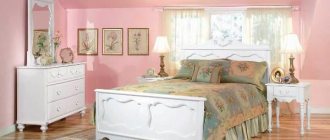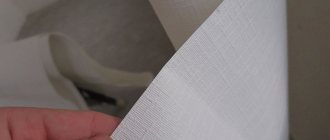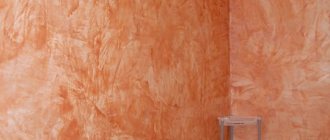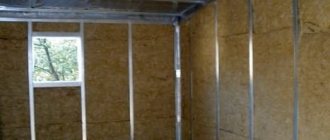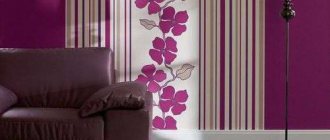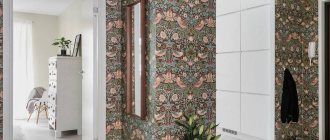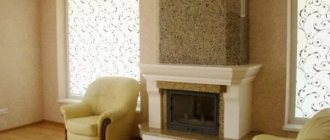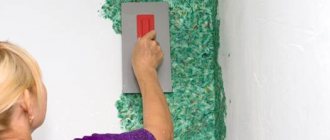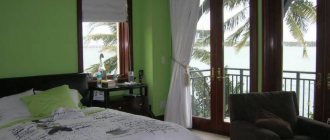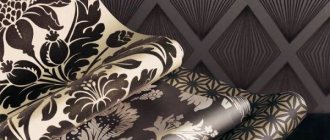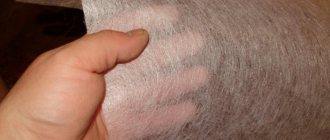Bathroom design - what kind of wallpaper can be glued? We suggest that you look into this issue thoroughly.
Bathroom decor is one of the most complex in an apartment. After all, it is important to take into account not only the color scheme, but also the features of the finishing material. In this article we will talk about wallpaper in the bathroom. We'll tell you which ones to choose and where to glue them.
Wallpaper in the bathroom interior.
Liquid wallpaper is the best alternative to tiles
For rooms with high humidity, liquid wallpaper is an original and justified solution. They are characterized by moisture resistance, the ability to absorb water vapor and high cleaning performance. If one of the sections is damaged during operation, it can be updated in 10-20 minutes.
Wallpaper in the bathroom looks beautiful
This is a high-quality finishing material for anyone who is interested in decorating their bathroom in an interesting way, showing creativity and out-of-the-box thinking, without using standard cladding. Liquid wallpaper can be described by two epithets - originality and exclusivity.
To realize your design ideas, you need to buy the powder at a hardware store and dilute it according to the instructions before use. You can use different colors, so you can combine shades (in much the same way as when using watercolors).
It’s just great if you know how to draw - with the help of liquid wallpaper and colors you can create full-fledged drawings and paintings on the walls of the room. The material is a suitable type of finishing for the realization of creative talent.
Liquid wallpaper is the best alternative to tiles
Decorative use options
An important advantage of the material is the variety of decor options offered in stores. When using standard wallpaper, there is only one option - stick on what you bought. With liquid material, the variations are limitless. You need to determine the main color or several shades, and also decide how to apply the new finishing material.
The most popular design solutions are:
- Simple and cheerful: we use only one shade to decorate the bathroom. The option is interesting because in cases where you get tired of the color, you can add bright colors in a few hours of work using a new mixture, mosaic, or stickers.
- Universal: we buy one dry composition, create a finishing material with different shades using colors. As a result, the bathroom interior takes on an original look. Wide scope for imagination - do what you want!
An important advantage of the material is the variety of decor options
- Various: liquid wallpaper can be applied in various ways. We take a roller or any other suitable tool and smear the finishing material on the wall with stripes, ornaments, patterns - as you please! To form a complex pattern, it is recommended to first draw the outlines of future figures on the walls, and then paint over them with the composition. If you can’t make clear contours, it’s okay, because before it dries completely, the finish can be washed off with water, correcting all the inaccuracies.
- Unusual: you can use relief and structural rollers to create a unique decor or stucco effect using liquid wallpaper. To do this, you need to apply two layers: thin and thick (with a relief roller).
How to glue photo wallpaper
The specifics of working with roll moisture-resistant wallpaper, in principle, do not differ significantly from the use of materials that are not resistant to water. But the magazine "GidOboev" reminds: moisture-resistant coatings do not allow water to pass through at all or almost, so the walls should be dried especially carefully before pasting. Otherwise, a favorable environment for the growth of mold and the proliferation of small insects will be formed between the wallpaper and the surface of the wall, and the canvases themselves will peel off much faster.
Preparing the base
This stage includes, first of all, if necessary, leveling the walls. If you choose not smooth and plain wallpaper, but one with texture and patterns, then minor irregularities will be hidden, but, of course, there should be no large bulges or dents. If the wall needs to be leveled significantly, it is plastered, then a thin layer of putty is applied. If the unevenness does not exceed a couple of millimeters, then it is enough to putty. Then, to improve the adhesion of the wallpaper to the wall, the latter must be coated with a primer - a liquid containing fine-grained sand-like elements.
Advice
For convenience, it is advisable to mark the wall using a level in accordance with the selected width of the canvas - this will significantly reduce the chance of pasting the wallpaper crookedly.
Pasting process
The glue is diluted in the proportions indicated on the packaging and applied, depending on the type of wallpaper, to the wall and/or canvas. Then the canvas is attached to the wall, starting from the top, and smoothed, getting rid of creases and air bubbles trapped under it, with a soft rag, roller or something similar.
In general, corners are pasted over as follows: on one side, the canvas should overlap the perpendicular wall by 3-4 cm, on the other, this gap is covered with a canvas cut exactly along the line of the corner. But if in this way the design turns out to be cut off in the most inappropriate place, and the corners in the bathroom are perfectly even, then you can take a chance and bend the canvas without cutting it in the corner. In this case, it is advisable to first fix the wallpaper on one wall, make sure that it fits as tightly as possible to the corner, wait until the glue sets a little, and only then glue the canvas to the perpendicular wall.
Joining individual paintings can be especially difficult, because a seam that is invisible in an abstract drawing will most likely be visible in a realistic depiction. There are several ways out:
- choose wallpaper that covers the entire wall (often in this case the canvas has to be made to order);
- choose wallpaper designed for matching (with a repeating pattern) or a plain background;
- frame the photo wallpaper canvas with other wallpaper or other finishing material that matches the style and color scheme.
How long it will take photo wallpaper to dry in the bathroom depends on the thickness of the canvas, glue, temperature and humidity, on average it can be 1-2 days. During this time, it is advisable to ensure that there is no draft or strong changes in humidity in the room. After a few days, it is worth applying a thin layer of a matching color or transparent sealant to the joints of the canvases, which will prevent liquid from entering the seams and extend the life of the entire finish.
Manufacturers of liquid wallpaper
The bathroom is a specific room, so finishing materials for it need to be chosen wisely. The world market leader in the production of liquid wallpaper is Senideco. The company manufactures products that comply with international standards and norms.
You can use different colors
If you want to add a “zest” to the interior, then you should pay attention to the French manufacturer Cotex. The company produces a finishing coating in which you can add glitter and various grain inclusions, which gives the finish texture. In some cases, Swarovski crystals are added to the solution.
The leading Russian manufacturer is. The company's products are inexpensive, high quality (different colors can be combined well with them). Optimal for bathrooms in country houses, country houses, cottages.
Advice When choosing a material, if finances allow, there is no need to buy the cheapest and simplest liquid wallpaper (especially if the bathroom uses high-quality plumbing fixtures and beautiful decor). Low-quality compounds will not last long (usually they last only a few years). They may also contain harmful substances.
We pay attention to the quality of the material
Regardless of the manufacturer, country of manufacture, or cost of the product, you should study the packaging before purchasing. You should look through it, finding the line that the finishing material used is suitable for use in rooms with high humidity.
Let's sum it up
Moisture-resistant photo wallpaper for the bathroom is an excellent alternative to tiles or plastic panels in the decoration of this room. They are practical, functional, easy to work with, and the ability to choose absolutely any image for printing will help you create a truly unique interior in the bathroom of your dreams.
Various wallpaper combination options
How to choose wallpaper for a hallway with a dark door?
Design options with wallpaper in a marine style
Wallpaper and tiles
Decorating a bathroom with wallpaper and tiles is a smart solution that allows you to create an interesting, original interior. The solution is especially relevant if the room is not small (in small apartments, a variety of finishes will look ugly and colorful).
The following types of wallpaper are optimal for use in rooms with high humidity:
- vinyl;
- liquid;
- glass wallpaper;
- all types washable (eg metal coated, acrylic).
Product print with birds
Tiles and wallpaper - optimally dividing the bathroom into separate zones. For example, you can tile those areas that will get wet the most (floor, walls near the shower, bathtub, sink). It is recommended to paste wallpaper where the towel dryer, entrance to the room, toilet cabinets, towel rack, and washing machine are located.
Tip Don't forget about the color combination.
For example, beige tiles will look good only with black or white wallpaper or patterned canvases. It is necessary to pay attention to the junction of the two materials, because in the case of unevenness or curvature, it will be this that will catch the eye, and not the beauty of the design.
In green
Tile laying options
You can lay tiles using a variety of techniques - it all depends on your ideas, the intended design, and the size of the tile products. Popular installation options are:
- Traditional technique . Provides for laying tiles in even rows to form a single grid (regardless of the size of the products).
- With offset . Laying is done obliquely with a sideways shift with each subsequent product.
- Diagonally . In this case, installation is carried out from the corner of the wall or floor surface. A good solution to use is small square tiles.
Experts note that there are more than 40 different options for laying tiles. To create a unique, interesting design in your bathroom, it is recommended to explore different solutions. It is not recommended to combine tiles of different shades and sizes on your own (in this case, it is better to seek help from a designer).
Blue color of the product in combination with white
One solution for combining tile shades is to take black and white tiles (or products in other contrasting shades). In this case, it will be possible to easily choose wallpaper that matches the color (for example, beige canvases will be just perfect).
To create the decor of kitchens and bathrooms, traditional tiles, which are represented by small square products, are often used. Depending on the intended design and size of the room, the tiles can be small (no more than 10 cm) or larger.
Wall decoration
It is difficult to combine ceramic tiles and wallpaper in one room, as it may seem at first glance. If the bathroom is small, it is strongly not recommended to use bright finishes. If you want to do something catchy, you can paint one wall (for example, where the bathtub is) in a bright color.
A classic that never goes out of style
If one wall is bright and catchy, then the tiles and other canvases should be made in extremely calm, simple shades. This will make the room look harmonious and beautiful. For example, a bright blue or light blue finish on one wall will be perfectly combined with the bed tones of other finishing materials.
One of the most common techniques when using tiles and wallpaper in the same room is to create a vertical or horizontal line. It is formed using tiles of a different color (they should be small in size). Such a solution will allow you to decorate the interior (using a vertical line can clearly delimit the space into zones).
You can decorate and design your bathroom in an unusual way by alternating tiles in a checkerboard pattern. It is not necessary to choose black and white products - any type of tiles whose colors go well together will do. For example, these could be the following combinations: red-green, blue-orange, yellow-brown.
Combination of plain and printed wallpapers
Rules for combining wallpaper and textures
Wallpaper, together with floor coverings, correctly and stylishly selected plumbing fittings and lighting can create a unique and original interior even for a small bathroom.
A plain bathroom finish is universal, giving the room a noble, but sometimes too strict appearance. Sometimes it doesn't look good. Wallpaper with patterns, lines and bright elements will help add playfulness and movement to the room. Combine them with monochrome and you will get an original effect.
Plain bathroom decoration with wallpaper.
Combine wallpaper with tiles of similar colors; you may be able to find tiles that repeat some of the wallpaper's design elements.
Don’t forget about the classic version of combining two types of wallpaper with each other. For example, dark-colored wallpaper with a bright pattern is glued at a distance of one meter from the floor, and the top is decorated with wallpaper that is lighter in tone, but with similar elements.
A combination of dark wallpaper with light flooring.
Vinyl wallpapers
Vinyl wallpaper is used in many countries around the world to decorate bathrooms and kitchens. They are presented in the form of two-layer canvases. The stores sell canvases with different patterns and color designs:
- Solid colors (red, white, gray, blue, yellow, etc.).
- Striped.
- Multi-ton.
- With an image.
- Embossed with a pattern.
Vinyl products are used in many countries around the world
For rooms with high humidity, you should choose vinyl wallpaper labeled “kitchen vinyl” . These are special washable sheets that were created for use in kitchens and bathrooms. The models are created on the basis of rubberized vinyl, which is resistant to moisture and dirt.
Often "kitchen vinyl" is used in bathrooms instead of or in combination with ceramic tiles. The material is relatively thick (compared to other types of canvas), so it will look rough in the room. Therefore, it is recommended to diversify it with suitable decoration solutions.
Suitable for areas with high humidity
What types of vinyl wallpaper are suitable for the bathroom?
The top layer in canvases of this type can be different. It determines the appearance of the coating, sound absorption, and thickness of the material. It is customary to distinguish several types:
- Smooth . Embossed, high-strength models, easy to clean. Decorated with brick, stone and other popular materials.
- Solid . Cloths with a dense structure that are resistant to various negative influences. They also imitate well-known finishing and building materials. You can choose an option to match your existing bathroom design.
- Silk . Canvases with a beautiful texture reminiscent of silk fabric. Such vinyl wallpapers are produced using silk-screen printing technology.
- Embossed foam vinyl . The presence of a foam layer allows the canvas to “breathe”. The models have a relief, clear pattern, so they are well suited for decorating bathrooms and kitchens (especially if there are slight unevenness on the walls).
Models are created on the basis of rubberized vinyl
The idea is that for rooms with high humidity, you can choose any type of vinyl wallpaper, based only on your preferences in appearance. Such canvases combine perfectly with ceramic tiles and other finishing materials.
Printing methods
When choosing canvases, it is recommended to pay attention to the technology that was used to print the design or pattern on the material. Manufacturers use different printing methods to apply images to vinyl. Popular ones are:
- Regular printing . It is used when a single color or simple patterns need to be applied to the canvas. Such models are monochromatic and can have traditional, simple images and designs, which are represented by patterns, figures, and ornaments.
- Photo printing . Canvases on which the image is applied using photo printing have a magnificent appearance. The applied drawing has good detail, high clarity, rich and bright shades. It was popular before, but now this solution is used relatively rarely in bathrooms and kitchens.
- UV printing. Vinyl is produced with bright, clear, slightly shiny images and patterns that have a three-dimensional effect. If bright light hits the surface, the canvas shimmers. An excellent option for bathrooms and bathrooms.
- Printing using stereoscopy technology . One of the most modern and interesting printing methods, the use of which allows you to obtain a 3D effect. The picture can be single, occupying the entire wall, or panoramic. Large enterprises can custom-make models that glow in the dark (due to built-in LEDs).
Creating accents
Vinyl wallpaper is great for highlighting the main area in the bathroom. To do this, it is recommended to use fabrics that have a contrasting shade. For example, if the floor and walls are (partially) tiled with white tiles, then one option is to create an accent with red vinyl wallpaper.
Bright room design option
You can cover two walls with eye-catching and bright wallpaper, continuing the composition to the ceiling. Upon entering the room, this composition will immediately catch your eye. It must be designed taking into account the existing interior style and the implemented color scheme.
A good solution for creating an accent is a combination of vinyl photo wallpaper with wallpaper of another type. It is recommended to glue photo wallpaper all over the wall. In this case, it is necessary to ensure that the color scheme of the overall composition matches the other finishing materials used.
Types of wallpaper for the bathroom
Nowadays, people who want to decide on the layout of wallpaper in their bathroom can choose between two types of wallpaper that are suitable for this and can provide the perfect appearance of the walls for a long time. The first is vinyl wallpaper for the bathroom , the second is fiberglass wallpaper . Opinions and reviews about wallpaper made from these materials are very flattering and are very popular. Let's find out what exactly they characterize.
VINYL WALLPAPERS
The first type of wallpaper you can use is vinyl bathroom wallpaper , which comes in two varieties. These are wallpapers covered with PVC film and wallpapers made of foam vinyl. The first of them are very resistant not only to moisture, but also to mechanical damage, but do not provide adequate air circulation.
The latter perfectly hide the unevenness of the walls and allow them to “breathe”. The advantage of vinyl wallpaper for the bathroom is its resistance to moisture, chemicals and sunlight. The disadvantage is the rather high price.
It is worth knowing that wallpaper covered with a thin layer of vinyl can only be used on very flat surfaces. They are very easy to keep clean because they are resistant to cleaning and washing. Thanks to their shiny finish, they brighten and optically enlarge the bathroom. Wallpaper with a denser top layer, in addition to being highly resistant to moisture and damage, covers uneven surfaces very well. Some of them are coated with glue at the factory, which makes wall finishing much easier and faster.
FIBER GLASS WALLPAPER
The second type of wallpaper that can be used in the bathroom is fiberglass wallpaper . This is one of the hardest and most durable wallpapers available on the market today. At the same time, despite their resistance to moisture and other factors, they provide excellent air circulation. Interestingly, they are also non-flammable. Their advantage is also the fact that you can use them to cover uneven walls. They also do not promote mold growth, which is very important for allergy sufferers.
Unfortunately, fiberglass bathroom wallpaper has its drawbacks. First of all, this is the price - even higher than in the case of vinyl wallpaper, and the fact that fiberglass does not allow you to achieve rich, deep colors. However, this type of product is available in hundreds of different designs.
These types of wallpaper also have a fabric-like texture. It protects walls and masks plaster defects. They can be painted even no more than 6-7 times. These types of wallpaper can be used on concrete, plaster, plasterboard, chipboard, wood, plastic or metal. The downside is that they are difficult to remove from walls without damaging the plaster. There are few such wallpapers on the market yet, so the number of designs is limited.
WHAT WALLPAPERS ARE CURRENTLY FASHIONABLE IN BATHROOMS?
Bathroom wallpaper is now available in a wide range of designs and options, with something for everyone - whether you love classic or modern minimalism. However, there are ideas that are currently the most fashionable.
These include wallpapers that resemble brick or natural stones, wallpapers with floral motifs, wallpapers with exotic patterns and wallpapers with geometric patterns. At the same time, when choosing wallpaper with a strong colorful theme, let's make sure that it is only on one, the smallest wall. Otherwise, it may ruin the interior.
WALLPAPER FOR A SMALL BATHROOM
It cannot be hidden that in many apartments the bathrooms are small and cramped. In this case, you can also decorate the walls with wallpaper. But by all means, you should focus primarily on wallpaper in bright colors that will visually enhance the interior. It is important to note that bright colors are also suitable as wallpaper for the bathroom ceiling.
If the bathroom you're remodeling is small, focus on small to medium-sized design and sophistication. It is also a good idea to combine wallpaper elements with ceramic tiles of similar colors.
Washable wallpaper
Washable wallpaper was specially created for use in various rooms with high humidity. Therefore, they are a suitable solution for kitchens, bathrooms, and toilets, where the problem of high humidity is especially acute. Such canvases can be combined with plaster finishing and tiled materials.
In black and white
When combining, the main thing is to correctly combine the shades and textures of various finishing materials. For example, if you choose embossed voluminous washable wallpaper, then the tiles should match. Color combinations are just as important, no matter what types of finishes are combined.
In the case of using washable wallpaper in bathrooms, experts give the following recommendations:
- The canvases must be combined with the overall style. A good example option is a combination of blue and green shades, which in the bathroom can create the effect of purity and harmony.
- If the room is small in size, then it is recommended to avoid using canvases in blue, red, and black shades.
- Bed and flesh tones will be a good solution when implementing a classic style in the interior of a bathroom. When choosing a Provence style, you can use washable wallpaper with a miniature floral print or vertical stripes.
- If the bathroom is medium to large in size, then the appropriate type of finishing would be canvases in orange and yellow shades. They will be able to bring more light and energy into the room.
Washable, suitable solution for kitchens, bathrooms, washrooms
When choosing washable 3D wallpaper, it is recommended to ensure that the canvas covers the entire wall. The image should not be interfered with by pipes, shelves and other plumbing and decorative elements. If the bathroom is small, then the image can be represented by a small bright picture.
Secrets of using colors and their combinations
When decorating a small bathroom, you should strive to visually increase the space. Light colors will help you with this, but do not opt for a pure white bathroom design. Because of this decision, the room risks becoming like a medical facility. In addition, despite the widespread myth, white color will not expand the room, but will make it more illuminated. But don’t give up white altogether; dilute it with other colors that it goes well with.
Wallpaper in pastel shades in a light bathroom design.
For example:
- blue or blue;
- green and light green;
- wine red;
- purple or lavender;
- gray and pearl.
Beige wallpaper in the design of a modern bathroom.
Also, do not give up dark colors. They will not reduce the visual space at all; on the contrary, they will give it depth if you choose the right colors.
Our human eye divides all colors into three different types:
- Cool: blue, green, purple shades.
- Warm: yellow, red, orange shades.
- Neutrals: white and shades of gray.
Cool shades of wallpaper in the bathroom interior.
It is not recommended to combine warm and cold shades in a small bathroom; it is better to dilute them with neutral ones. The main thing is to ensure that the colors do not contrast with each other, but, on the contrary, combine well.
Owners of large bathrooms can afford to combine a greater number of color combinations and are not afraid to create contrasts. This will not reduce the space to a critical, uncomfortable size.
Metallic vinyl wallpaper in the bathroom interior.
Moisture-resistant wallpaper
Wallpaper with moisture-resistant properties is in demand and popular in the segment of finishing materials for kitchens and bathrooms. Such canvases are now available in various designs:
- Floral prints.
- Solid models.
- Striped.
- In a cage.
- With ethnic motives.
- With abstraction, with geometric shapes.
Wallpaper of this type is suitable for covering the entire room. But we recommend using combinations of different materials. This will allow you to create a high-quality room design, as well as extend the service life of the finish.
In light colors
It is recommended to combine two or more materials only if the area of the room is more than 5-6 square meters. For small bathrooms, you should choose simple design solutions without a combination of finishes and with a simple color scheme.
Where can I stick it?
When creating a bathroom design, it is necessary to take into account the practicality of using moisture-resistant fabrics. Several main areas can be distinguished:
- The first section is the wall surface above the bathtub, inside the shower stall, above the sink. These areas are most susceptible to direct exposure to water, so they try not to glue even moisture-resistant types of finishing materials to them.
- The second area is the surface 30-40 cm above the bathtub. It is considered suitable for the use of moisture-resistant canvases that have high strength and density.
- The third section is the area above 60-70 cm above the bathtub, sink, shower stall. These parts are considered relatively dry, so they are well suited for finishing with various types of wallpaper (but not ordinary paper).
- The fourth section is above 80 cm above the bathtub. A safe and suitable area for pasting, which can be used to combine different fabrics.
It is recommended to decorate areas in the room that are most susceptible to constant exposure to moisture with ceramic tiles and porcelain stoneware. Wallpaper should not be used in these areas.
Design ideas - combining materials
Moisture-resistant wallpaper is well suited for combination with other materials in the bathroom. With them, the combinations turn out to be harmonious, light, simple. This allows you to create an interesting and unique interior, even using inexpensive finishing materials.
A popular combination is the use of moisture-resistant wallpaper and tiles. Typically, ceramics are installed in areas that are exposed to direct water (the edge of the bathtub, near the sink, etc.). A good solution in this case is to glue the wallpaper above the tiles.
Combined with tiles
In the interior of bathrooms, tile materials are also often used to form mosaics on a separate surface or near plumbing fixtures. In this case, they try to choose wallpaper so that it matches the color and texture of the tile and does not stand out against its background.
If you want to create an environmentally friendly interior with an unusual design, then moisture-resistant wallpaper in the bathroom can be combined with stone or wood. Artificial or natural stone can be used in any texture and color scheme (it is easier to match the canvas to the stone than vice versa). If wood is used for the combination, it must be treated with moisture-proof compounds, otherwise it will quickly become unusable.
If you want to save a little on decorating your bathroom, you can use plastic panels. They also combine well with moisture-resistant wallpaper and are practical and easy to install. This is a good option for use together with photo wallpaper or single-color canvases.
Bohemian, classic style
Wallpaper with panels can be alternated or combined by zone. For example, the lower part of the room is decorated with panels, and the upper part with moisture-resistant fabrics. Plastic trim is almost always installed in areas exposed to water.
Alternative options
When deciding how to wallpaper in the bathroom, you can use alternative options, use oilcloth for the walls, self-adhesive PVC film, liquid wallpaper or glass wallpaper. Let's consider these options in more detail.
Oilcloth for walls
An inexpensive but practical solution is oilcloth for bathroom walls. This is a completely synthetic material that is not afraid of moisture:
- To glue the oilcloth, you can use PVA or Bustilat glue.
- The glue must be evenly applied to the entire oilcloth panel, since if you leave areas ungreased, an air bubble will form in this place.
- Before gluing the oilcloth, you need to treat the walls with primer or glue diluted with water.
- Start gluing the oilcloth from the corner; to smooth it you need to use a soft cloth or roller.
Advice! To prevent the seams from coming apart, strips of paper should be glued over the joints and coated with wallpaper glue. After drying, the strips will need to be carefully removed by wetting them with water. It is worth gluing strips of paper matching the color or fillets to the upper junction of the oilcloth to the ceiling.
Self-adhesive PVC film
This is another inexpensive option for wall decoration. When using this material there is no need to use glue, the film is self-adhesive. Pasting the film is no more difficult than wallpaper; it is cut into strips of the required length, and then applied in place and the protective paper is carefully removed, while smoothing the film.
Liquid wallpaper
This name is given to water-based plaster, which after completion of the work becomes one hundred percent moisture-proof. Liquid wallpaper for the bathroom is applied using a sprayer or manually using a trowel and a plastic grater.
Glass wallpaper
When choosing moisture-resistant wallpaper for the bathroom, you should pay attention to glass wallpaper. The basis of this material is specially processed glass. The raw material is heated to high temperatures, then fibers are pulled out of it, from which the base of the wallpaper is then created.
That is, fiberglass is woven together like threads on a loom. The created canvas undergoes additional processing, due to which the material acquires a stable shape.
Fiberglass wallpaper is created from natural raw materials. The main raw materials for their production are quartz, clay, and dolomite. Therefore, the material is environmentally friendly. Why should you use fiberglass wallpaper in your bathroom? Their main advantages:
- Breathability. Such wallpaper in the bathroom will not interfere with natural air circulation, and this will prevent the growth of mold fungi.
- Hygiene. Walls covered with fiberglass wallpaper can be washed using detergents that do not contain abrasives.
- Durability. If the walls are decorated with fiberglass wallpaper, then the repairs will not need to be repeated for a long time. If you want to update your interior, you can simply repaint the wallpaper.
- Strength. Despite the fact that the basis of such wallpaper is glass, they are distinguished by a high level of strength.
- Moisture resistant. Like ordinary glass, wallpaper based on this material does not collapse under the influence of humid air and is not afraid of direct contact with water.
- Fire safety. This material does not support combustion and does not emit toxic substances when heated.
Waterproof glass wallpaper will allow you to create a beautiful and durable coating with minimal effort, ideal for finishing bathroom walls. This is the most durable option of waterproof wallpaper, but it also costs significantly more than vinyl-based wallpaper.
Conclusion
Whether to wallpaper your bathroom or not is your decision. Above, we looked at the main options for using this finishing material in high-humidity environments, gave basic advice on this topic, and talked about the nuances.
In stores you can choose canvases that can complement the existing interior. For example, if you use wallpaper to create bright and catchy accents in the center of the bathroom, or near plumbing fixtures.
VIDEO: Choosing the best wallpaper for the bathroom
Wallpaper for the bathroom
New possibilities for long-familiar material
Is it possible to wallpaper in the bathroom?
Wallpaper, which in our opinion is of poor quality and cannot cope with the demanding conditions in the bathroom, predates the real revolution that took place in the world of interior design.
Thin paper wallpapers, which were indeed susceptible to mechanical damage and did not allow contact with water and moisture, have been replaced by modern materials that represent a completely new quality and are ideal for the bathroom or kitchen.
Printing technology has also changed. Nowadays, instead of inks that contain harmful solvents, latex printing is used, which is equally durable and you will not find any toxic substances in it. So it's not only practical, but also environmentally friendly.
Wallpaper that can do more. What wallpaper should I put in the bathroom?
What conditions must a wallpaper meet before we decide to place it in such a demanding room as a bathroom? Of course, the wallpaper must be waterproof . This means that not only can direct contact with water not harm them, but they must also remain resistant to airborne moisture, which will certainly accumulate in the bathroom.
This effect is guaranteed by vinyl wallpaper . Polyvinyl chloride, like a magic spell, makes wallpaper resistant to both mechanical damage and the harmful effects of water. Additional protection can be a laminated layer.
Moreover, bathroom wallpaper should “breathe” or allow air to pass through. If the material is not vapor-permeable, uninvited guests in the form of mold or mildew may appear under the wall decoration, which is very harmful to health. If you choose wallpaper for your bathroom with these properties, you can be sure that it will serve you for many years and, of course, will not peel off the walls.
What wallpaper is suitable for the bathroom
When choosing wallpaper for the bathroom, the main thing to remember is that ordinary paper-based products will not work.
Preference should be given to moisture-resistant wallpaper, preferably those marked “three waves”. They are considered the most resistant to temperature influences, so they can be used in conditions of high humidity in the bathroom.
The choice of glue is also important, since the quality of gluing the joints between the wallpaper sheets determines their service life. To ensure that walls with wallpaper do not lose their attractiveness, and that there are no unpleasant emotions left after the renovation, the wallpaper glue must be moisture resistant.
It is necessary to use a moisture-repellent adhesive composition with antifungal additives. It is not only resistant to moisture and temperature changes, but also protects walls from mold and mildew.
